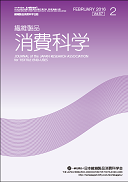
- |<
- <
- 1
- >
- >|
-
[in Japanese]2013Volume 54Issue 7 Pages 618-619
Published: July 20, 2013
Released on J-STAGE: June 30, 2017
JOURNAL RESTRICTED ACCESSDownload PDF (1664K)
-
[in Japanese]2013Volume 54Issue 7 Pages 623-626
Published: July 20, 2013
Released on J-STAGE: June 30, 2017
JOURNAL RESTRICTED ACCESSDownload PDF (1365K)
-
[in Japanese]2013Volume 54Issue 7 Pages 627-632
Published: July 20, 2013
Released on J-STAGE: June 30, 2017
JOURNAL RESTRICTED ACCESSDownload PDF (1369K)
-
[in Japanese]2013Volume 54Issue 7 Pages 633-636
Published: July 20, 2013
Released on J-STAGE: June 30, 2017
JOURNAL RESTRICTED ACCESSDownload PDF (1080K)
-
[in Japanese]2013Volume 54Issue 7 Pages 637-640
Published: July 20, 2013
Released on J-STAGE: June 30, 2017
JOURNAL RESTRICTED ACCESSDownload PDF (1110K) -
[in Japanese]2013Volume 54Issue 7 Pages 641-645
Published: July 20, 2013
Released on J-STAGE: June 30, 2017
JOURNAL RESTRICTED ACCESSDownload PDF (1391K)
-
―The Influence of Polka-dot Patterns on the Apparent Configuration of Curtains―Shoko TANI, Kuniko MATSUNASHI, Kozo SHIMAZAKI2013Volume 54Issue 7 Pages 646-655
Published: July 20, 2013
Released on J-STAGE: June 30, 2017
JOURNAL OPEN ACCESSIn a previous study, we showed that the printed pattern on curtains affects the apparent configuration. In this study, we considered curtains with a printed polka-dot design and examined the influence of this pattern on the apparent configuration. In the experiment, we kept the configuration of the curtains constant but changed the dot size, the percentage of the area covered by dots, and the arrangement of the dots. A sensory test was performed, and the following results were obtained:
1) The plain curtain (without dots) was perceived to have the most regular configuration and was also considered very attractive.
2) The curtain with dots of 3 cm in diameter was perceived to have more pleats than those with dots of 7 cm or 15 cm in diameter.
3) There was no significant statistical difference in the sensory evaluation between the squared and alternating dot arrangements.
4) The curtain in which the size of dots and the size of the pleats were synchronized was perceived to have a greater number of more regular pleats.
5) The images of the curtains were analyzed by factor analysis, and the two factors of “texture” and “form” were extracted. It was shown that the texture and form factors were strongly related to Abstract the percentage of the area covered by dots and the size of the dots, respectively.
View full abstractDownload PDF (3262K) -
Waka KAGIYAMA, Evelise Anicet RÜTHSCHILLING2013Volume 54Issue 7 Pages 656-663
Published: July 20, 2013
Released on J-STAGE: June 30, 2017
JOURNAL OPEN ACCESSThe purpose of this study is to obtain an approach to underwear planning and design for multi-ethnic users. The market research on underwear in Brazil, underwear usage (n=241), body image perception (n=229), and the owned brassieres (n=50) of Brazilian women university students (17 to 39 year-old) were investigated. A three-quarter cup underwire, simple design, molded cup, under free type brassieres were mostly observed in the Brazilian market. Also, it was shown that the survey participants’ brassieres tended to be the same type. Shorts not covering all hips were mostly worn by 83%. It indicates that invisible underwear and natural looking silhouette were preferred. The ideal body form was hourglass shape for body figure, hemisphere shape for breast and triangle shape for hips. In order to approach to the ideal breast, using brassieres was most common and secondly plastic surgery was answered by 55%. When comparing body perception between Brazilian and Japanese students, even though Brazilian are thicker than Japanese, they evaluated their own body as thin and did not show aspiration for slenderness like Japanese ones.
View full abstractDownload PDF (1928K)
-
[in Japanese]2013Volume 54Issue 7 Pages 664
Published: July 20, 2013
Released on J-STAGE: June 30, 2017
JOURNAL RESTRICTED ACCESSDownload PDF (518K)
-
[in Japanese]2013Volume 54Issue 7 Pages 680-681
Published: July 20, 2013
Released on J-STAGE: June 30, 2017
JOURNAL RESTRICTED ACCESSDownload PDF (1120K)
-
2013Volume 54Issue 7 Pages 685
Published: July 20, 2013
Released on J-STAGE: June 30, 2017
JOURNAL RESTRICTED ACCESSDownload PDF (612K)
- |<
- <
- 1
- >
- >|